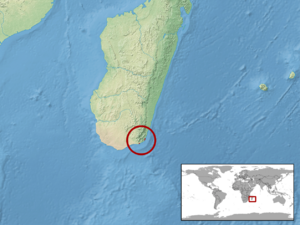Phelsuma antanosy facts for kids
Quick facts for kids Phelsuma antanosy |
|
|---|---|
| Conservation status | |
| Scientific classification | |
| Genus: |
Phelsuma
|
| Species: |
antanosy
|
 |
|
The Phelsuma antanosy, also known as the Antanosy day gecko, is a special type of gecko. It lives only in the coastal Anosy Region of Madagascar. Scientists Christopher Raxworthy and Ronald Nussbaum first found this gecko in 1993.
The Antanosy day gecko is one of about 45 different species in the Phelsuma group. Since 2011, this gecko has been on the critically endangered list. This means it is at very high risk of disappearing forever. Not much is known about this gecko because it was found recently. Also, not much research has been done on it. But, its small and separated living areas led to it being listed as critically endangered.
Contents
What Does the Antanosy Day Gecko Look Like?
The Antanosy day gecko is one of the smaller geckos in the Phelsuma family. It grows to be about 10 centimeters (4 inches) long. Its body is a bright green color. It has cool patterns on its back and head.
Three red lines run down its back, starting from its tail end. The middle red line is the brightest. On its head, it has two red stripes that look like crossbars. It also has a reddish-brown line on its lip, from its nose to its eye. Between the red stripes on its head, and near its eyes, are blue spots. The gecko's belly, throat, and tail are all white.
Where Does the Antanosy Day Gecko Live?
Over the years, a lot of land in Madagascar has been developed. Forests have been cut down, sometimes by as much as 50% since 1950. Much of this land is used for mining and other building projects.
Because of this loss of land, the Antanosy day gecko's home has been broken up. Its population is now split into two main areas in the Anosy Region. These two areas are called Ambatotsirongorongo and Saint Luce.
The total area where these geckos are thought to live is only about 16 square kilometers (6 square miles). These small, separated areas are located very close to the coast. They are about 0.1 to 4 kilometers (0.06 to 2.5 miles) from the ocean.
Habitat and Daily Life
The Antanosy day gecko lives in forests near the coast. It also lives in forests that are changing, or in damaged forests with thick tree cover. These places provide a good home for them.
The Antanosy day gecko really depends on a plant called the screw palm (Pandanus). Female geckos use these plants especially for laying their eggs.
These geckos look for food both during the day and at night. They eat from plants like Dypsis palms, such as the Saint Luce Dypsis (D. sainteluccei). They also eat from the Ravenala madagascariensis plant, which is also known as the traveler's tree.
Population Numbers
Right now, the Antanosy day gecko lives in three smaller groups. These groups are found in Ambatotsirongorongo and Saint Luce, Madagascar. About 40% of all the geckos live in Saint Luce. The other 60% live in Ambatotsirongorongo.
Because their homes are separated, the gecko population is very broken up. Experts believe there are only about 5,000 to 10,000 geckos left. This means there are only about 10 geckos per hectare (about 2.5 acres) in good living areas. Cutting down trees and destroying their homes has caused their numbers to keep going down.
Why Are They in Danger?
The Antanosy day gecko is losing its home because of tree cutting and habitat destruction. They are losing the land they need to live, especially the plants they rely on. The screw palm plant (Pandanus), which is important for egg laying, grows back very slowly. This leaves the geckos without their special habitat.
Even though some areas where the Antanosy day gecko lives are protected, unauthorized tree cutting still happens. The government and local people also put pressure on the land. Forest resources are being used for personal needs. There are also plans for mining in some areas. These actions could lead to a loss of up to 20% of the gecko population.
How Are People Helping?
The SEED Conservation Research Program (SCRP) and the Mohamed bin Zayed Species Conservation Fund are working to help. They have a team of researchers and volunteers collecting information about the Antanosy day gecko. SCRP hopes that by studying the gecko's behavior and its environment, they can help them survive.
One idea is to start a captive breeding program. This means raising geckos in a safe place to increase their numbers. The baby geckos would be protected from dangers outside. Another idea is to move some geckos to new, safe areas. These new places would have similar habitats and be officially protected. This would help ensure the future of the gecko population.
SCRP is also teaching kids in Saint Luce schools about the Antanosy day gecko. They have a conservation club to share information. Staff and volunteers talk about the dangers the geckos face. They also explain why it's important to protect animals that only live in one place. Local guides are also being trained. They learn how to share correct information with their communities. This helps everyone keep an eye on the Antanosy day gecko's survival.


